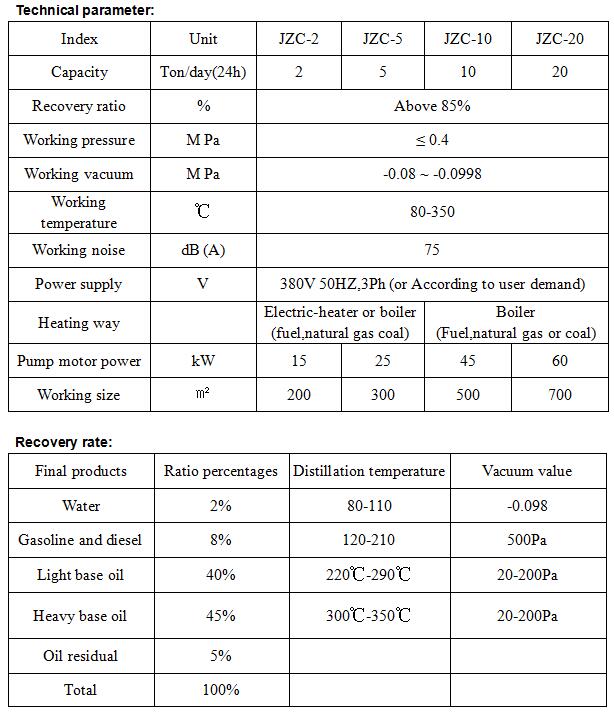Product ID:China
Product Info1:ZhongJing
Product Info2:JZC black engine oil refinery plant
Shelf time:2020-11-17
Product description:Purpose of waste oil distillation and regeneration equipment: The waste oil distillation regeneration ba se oil equipment
Purpose of waste oil distillation and regeneration equipment:
The waste oil distillation regeneration base oil equipment mainly purifies and regenerates the waste oil by distillation. According to the different pollution sources and impurity characteristics of the waste oil, it can effectively remove the debris, asphaltene, wax, impurities, water, acid, organic acid and inorganic acid in the waste oil. In the waste oil, oil deterioration is only part of the hydrocarbons, and most of the remaining hydrocarbon components are still the main viscosity carrier of lubricating oil. As long as the metamorphic substances and impurities are removed, the waste oil can be regenerated into base oil with the required quality, and then various additives are added according to the needs to prepare the required product oil. The main waste oils to be treated are waste oil, waste pressed oil, waste gear oil, waste black oil, waste quenching oil, waste heavy oil, waste diesel oil, waste lubricating oil, waste tire oil, waste plastic oil, waste cutting oil, etc. The waste oil regeneration distillation equipment belongs to energy-saving and environmental protection products. During the treatment process, the waste gas is treated by a special waste gas recovery system without air pollution. The treated sludge residue can be used as fuel again.
Introduction of waste oil distillation process
1. Transfer the waste oil to the distiller, start the heating system, heat at the same time, start the mixing device in the still to improve the heat transfer speed of the waste oil, so that the waste oil can be evenly heated in the distillation kettle. Because there are many impurities such as gum, asphalt, free carbon in the waste oil, stirring the waste oil can effectively prevent these substances from coking, thus blocking the distillation unit and pipeline.
2. The waste oil is gradually heated up in the distillation reactor. When the temperature reaches 55 ℃, the gasoline component in the waste oil will be gradually distilled out. The distilled gasoline is cooled by water and gasoline condenser to obtain extensive gasoline oil. When the temperature of the waste oil reaches 100-220 ℃, the water in the waste oil begins to be distilled out. The distilled water vapor is cooled by the water and gasoline condenser, and the cooled water and gasoline will enter the water and gasoline collector. Because the density difference between water and gasoline is very large, the two will automatically separate layers, drain the water in the collector, and then filter the gasoline to get the finished gasoline.
3. When the temperature reaches 160 ℃, close the valve of gasoline production line and switch to diesel production line.
4. With the gradual increase of waste oil temperature, the light components in the waste oil are gradually distilled out, and then these components are further catalytic cracked by the high-efficiency catalytic device, and then the oil vapor with diesel oil composition is obtained. After the oil vapor is cooled by the diesel condenser, the diesel oil is obtained.
5. When the temperature of the waste oil reaches 260 ℃, the heavier components in the waste oil are distilled out, and then pass through the high-efficiency catalytic device, which will carry out catalytic cracking of these heavy components. The oil and gas after catalytic cracking will enter the catalytic conversion device, and a certain amount of additives will be added into the auxiliary inlet of the catalytic conversion device, and the oil and gas after adding the auxiliary agent will pass through the catalysis The output pump enters the high efficiency catalytic device again for catalytic cracking again. In this way, we can get high-quality diesel oil steam, which will be cooled by the diesel condenser to get liquid diesel.
6. Finally, we filter all the diesel oil to get the finished diesel oil.
7. When the temperature of the still reaches about 410 ℃, start the residue oil pump to pump out the residual oil in the still, that is to say, the operation is completed. The residual oil obtained can be used as heavy fuel oil.
8. The non condensable gas produced during the distillation, catalytic and pyrolysis of waste oil is treated with tail gas, and the treated tail gas meets the emission standard for emission.
Advantages of waste oil distillation and regeneration equipment:
1. The equipment belongs to the project of environmental protection, energy saving and waste oil regeneration, which is beneficial to human beings;
2. Vacuum vacuum distillation is adopted for oil products with low distillation temperature and high working vacuum.
3. A new type of distillation tower with stereoscopic recycling tower is adopted, which has high distillation efficiency and low energy consumption.
4. The main parts of the equipment are made of stainless steel with long service life.
5. No chemical additives are added in the distillation process of the equipment, with low operation cost and no pollution.
6. The combination of oil cooling system and water cooling system has high cooling efficiency.
7. The design of the system is reasonable, the operation is simple and the maintenance is convenient. The residue after treatment can be used as fuel or other purposes.
Parameters of waste oil distillation and regeneration equipment:

Contact: Mr.Zhang
Phone: 0086-18580036904
Tel: web:http://www.zjzklyj.com/
Add: No. 137 Cave Industrial Park, Shapingba District, Chongqing